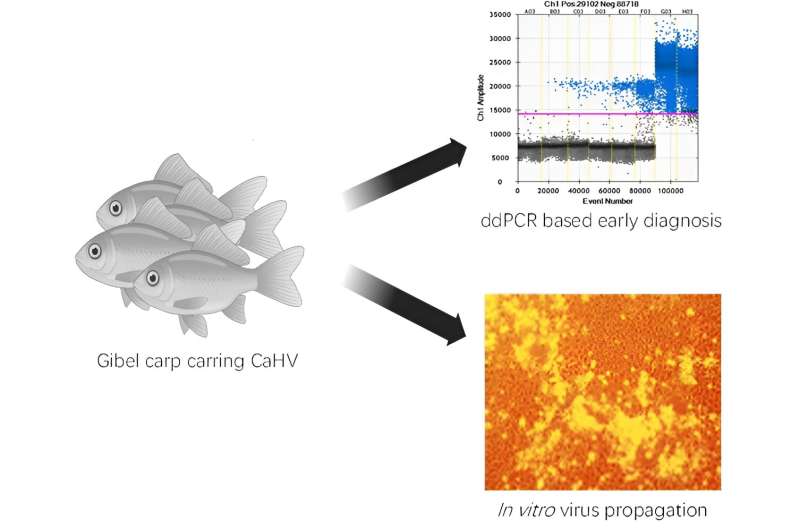This article has been reviewed according to Science X's editorial process and policies. Editors have highlighted the following attributes while ensuring the content's credibility:
fact-checked
proofread
A novel diagnostic for fish herpesvirus diagnostics and treatment

Researchers at the Institute of Hydrobiology, Chinese Academy of Sciences, have established a highly permissive cell line GiCS derived from the skin tissue of gibel carp (Carassius gibelio). This cell line, along with a novel diagnostic method, offers robust tools for the early detection and study of Carassius auratus herpesvirus (CaHV), according to two studies published in Water Biology and Security.
Gibel carp, a popular aquaculture species in China with an annual production exceeding 2.5 million tons, faces significant threats from infectious diseases, particularly those of viral origins. CaHV is known to cause severe gill hemorrhages and high mortality rates in gibel carp. Despite the virus being isolated and sequenced nearly a decade ago, knowledge on its pathogenesis has been limited due to the absence of a suitable cell line for in vitro virus propagation.
To that end, the researchers analyzed the pathway for viruses' entry into a fish. "Understanding the importance of the skin as the primary contact point with pathogens in aquatic environments, we focused on developing a cell line from this tissue," explains Ke Fei, senior author of the two studies.
The GiCS cell line, characterized by a modal chromosome number of 156, exhibits high susceptibility to CaHV and several other aquatic animal viruses. This marks the first time that CaHV can be stably cultured in vitro.
In addition, a detection method utilizing droplet digital PCR was developed. This method allows for the sensitive detection of CaHV in infected fish on the first day post-infection, with a detection limit of less than one copy per microliter.
"The newly established in vitro infection model will significantly benefit and expedite our research on the pathogenesis mechanism of CaHV. It also opens up avenues for developing cell-based vaccines against the virus," adds Ke. "With the droplet digital PCR method, we can now identify infected fish before clinical symptoms appear, enabling early intervention to prevent disease spread and reduce economic losses."
More information: Qi-Qi Jiang et al, A novel cell line established from skin tissue of gibel carp (Carassius gibelio) is susceptible to Carassius auratus herpesvirus infection, Water Biology and Security (2024). DOI: 10.1016/j.watbs.2024.100253
Yun Zhao et al, A droplet digital PCR method (ddPCR) for sensitive detection and quantification of Carassius auratus herpesvirus (CaHV), Water Biology and Security (2024). DOI: 10.1016/j.watbs.2024.100252
Provided by KeAi Communications Co.


















